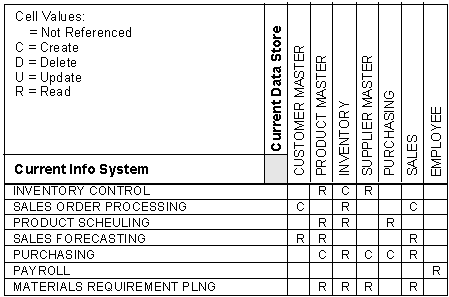

Analyzing Current Systems › Selecting Systems to Analyze
Selecting Systems to Analyze
Two matrices help you identify existing systems that support processes in the analysis model:
- Current Information System/Business Area Matrix—From this matrix, you select all systems that support processes in the defined business area. For example, during analysis of the Purchasing business area, the systems that should be selected are: Sales Forecasting, Purchasing, and Materials Requirements.

- Current Information System/Current Data Store Matrix—From this matrix, you determine the data stores to be analyzed in the defined business area. These are the data stores used by the three selected systems: all except the Employee data store.

These matrices may have been produced as part of an Information Strategy Plan or during initial project scoping. These matrices are supported in the planning and analysis toolsets.
You also review the scope and intention of the project with regard to current systems and data stores.
Current systems analysis confirms or qualifies these intended project outcomes:
- Retire a current system completely—Current systems analysis must produce an understanding of the functionality currently provided by the system.
- Modify or retire a current system in part—Here, current systems analysis is used to examine the parts of the system in sufficient detail to identify implications of this decision.
- Interface with a current system, reading only, or also updating—If there is an interface file or suitable input transaction file, this needs to be analyzed.
- Use a current data store, reading only, or also updating—The data store needs to be analyzed in detail.
You should probably examine the following existing systems:
- Current and planned systems that interact with data stores relevant to the business area, whether they are batch or online
- Systems that produce relevant specified output from these data stores for any purpose except occasional inquiry
- If the data store is not to be replaced, only those output processes that support the business area need be examined
- Application packages that access these data stores
- Manual procedures that operate on essential data stores independently, or are otherwise associated with the above systems
- When analyzing non-computerized systems or associated manual procedures, you should examine only procedures significant to the business. These do not include routine clerical tasks, unless they affect the content of data files or the form of information presented to or collected from end users.
The level of detail of the following analysis depends on whether the intention is to interface, access, enhance, or replace current systems and data stores completely or in part. It also depends on whether the original system development was done using CA Gen. For the systems and data stores to be analyzed, assemble and catalog system documentation, and assess the quality of this existing documentation and identify any further preparation actions.
- For a current system developed using CA Gen, obtain and analyze the appropriate model. Model objects from it can be merged or adopted as needed.
- For a system that has been analyzed already for another development project, obtain the analysis and check it for relevance and completeness.
- For a system with poor documentation, some documentation improvement may be necessary before analysis begins.
Copyright © 2014 CA.
All rights reserved.
 
|
|



